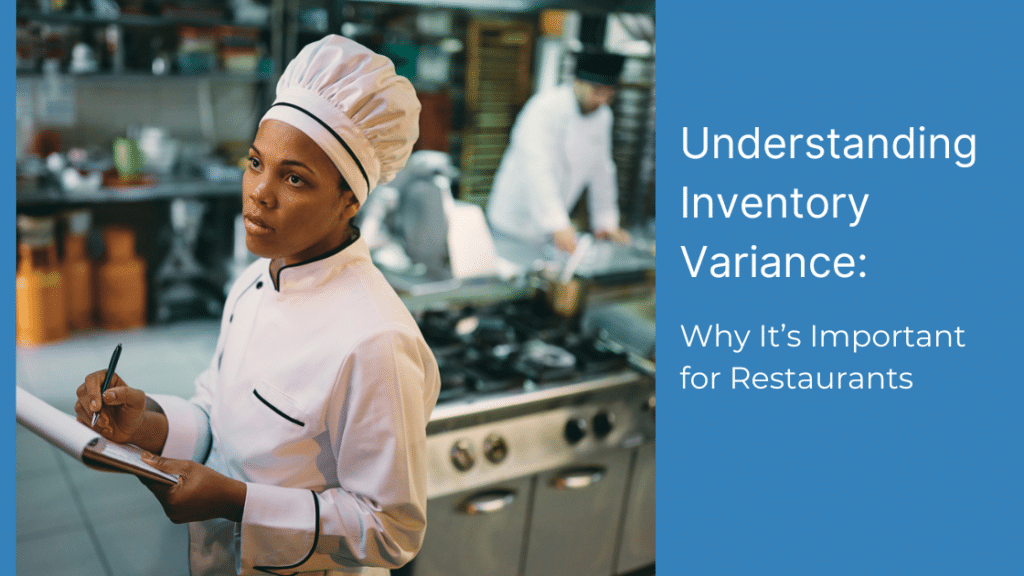For restaurants, where precise inventory management is essential for controlling costs and ensuring a seamless supply chain, understanding inventory variance is a critical aspect that can significantly influence the financial health and operational efficiency of an establishment. This introduction sets the stage for a deeper exploration into the intricacies of inventory management in restaurants, delving into the reasons behind variances and how a nuanced understanding of these discrepancies can empower restaurant owners and managers to optimize resources, reduce waste, and enhance overall profitability.
What Is Inventory Variance?
Inventory variance, also known as stock or inventory shrinkage, is a common challenge faced by restaurant owners and managers. It refers to the difference between the expected quantity of inventory and the actual quantity on hand. In other words, it’s the gap between what you think you have and what you actually have in your restaurant’s storage areas.
The Importance of Inventory Variance
Managing inventory variance is crucial for the overall success and profitability of your restaurant. Inventory variance serves as a critical performance indicator that reflects the accuracy and efficiency of a restaurant’s supply chain and inventory management processes. Understanding and addressing inventory variances are essential for controlling costs, minimizing waste, and optimizing resource utilization. Let’s explore the significance of inventory variance in more detail.
Impact on Cost Management
Inventory represents a significant portion of a restaurant’s assets, and any variance can have a direct impact on your bottom line. When inventory variance occurs, it can lead to increased costs due to over-ordering or under-ordering supplies, which can erode your profits over time.
Influence on Menu Planning
Inventory variance can also affect your menu planning. If you consistently have variances in key ingredients, it can disrupt your ability to offer certain dishes to customers. This can lead to customer dissatisfaction and a loss of repeat business.
Effects on Profit Margins
Maintaining accurate inventory records and minimizing variance is essential for preserving profit margins. High variance can result in wasted product and increased food costs, which directly impacts your restaurant’s profitability.
By closely monitoring the variance between expected and actual inventory levels, restaurant owners and managers can identify discrepancies, potential theft, or issues with ordering and storage. This knowledge empowers them to make informed decisions to enhance operational efficiency, maintain consistent stock levels, and ultimately maximize profitability.
Common Causes of Inventory Variance
Inventory variance can occur for a variety of reasons. Identifying these common causes is the first step toward effective inventory management. Recognizing and addressing these common causes of inventory variance is essential for restaurants aiming to maintain precise control over their stock levels, optimize resource allocation, and ultimately ensure a more profitable and resilient operation. Let’s explore them:
Human Error in Tracking
Human error is one of the primary culprits behind inventory variance. Miscounts, incorrect data entry, and misunderstandings during the tracking process can lead to discrepancies in your inventory records. Over time, these errors can accumulate and significantly impact your restaurant’s bottom line.
Supplier Discrepancies
Suppliers play a vital role in your inventory management process. Discrepancies in the orders you receive from suppliers, such as missing or incorrect items, can lead to inventory variance. It’s essential to promptly address and rectify these discrepancies to maintain accurate inventory levels.
Theft and Loss
Unfortunately, theft and loss can be a part of the restaurant industry. Whether it’s employees, customers, or external factors such as break-ins, theft and loss can contribute to inventory variance. Implementing security measures and monitoring inventory storage areas can help mitigate these risks.
Portion Control Issues
Inconsistent portion control during food preparation can also lead to inventory variance. If your chefs and kitchen staff are not following standardized portion sizes, it can result in overuse of ingredients and increased food costs.
Preparation Waste
Similarly to portion control issues, if inventory is prepared in a way that results in more waste than necessary, that waste can add up over time and lead to increased loss and inventory variance. And to top it off, the extra inventory is being fed to the trash can, instead of your customers.
Accidents
While hopefully not a terribly common occurrence, accidents like spills or mismanagement of storage measures happen, and can contribute to inventory variance. When the spill is just a small container, the difference likely goes unnoticed. But if a large container is dropped, broken, or spilled, a significant amount of inventory can be lost.
How to Calculate Inventory Variance
Calculating inventory variance is a fairly simple process, but one that should be repeated on a regular basis. Here’s a step-by-step guide to calculate inventory variance:
Conduct Regular Inventories: Begin by taking a physical inventory of all your items. This should be done regularly (weekly or monthly) for accuracy.
Record Usage: Track the usage of each item during the period between inventories. This includes all items used in the restaurant, whether for cooking, serving, or other purposes.
Calculate Expected Inventory: Use your sales data and recipe information to calculate the expected usage of each item. For example, if you sold 100 dishes that use two tomatoes each, you would expect to have used 200 tomatoes.
Determine Actual Inventory: At the end of your inventory period, conduct another physical count of your stock.
Calculate Variance: The formula for the inventory variance over a specific time period is:
Inventory Variance = ( Beginning Inventory + Purchases ) − ( Ending Inventory + Usage )
- Beginning Inventory: Stock at the start of the period
- Purchases: Additional stock bought during the period
- Ending Inventory: Stock at the end of the period
- Usage: Expected usage based on sales and recipes
Analyze the Results: A positive variance indicates you have less stock than expected, suggesting issues like waste or theft. A negative variance means you have more stock than expected, which could indicate over-purchasing or errors in tracking. Remember that having some variance is normal, but shouldn’t exceed a percentage or two in either direction, positive or negative.
Implement Solutions: Based on your findings, take appropriate actions. This might involve tightening inventory controls, adjusting purchasing habits, or reevaluating portion sizes.
Remember, SynergySuite’s advanced inventory management tools can automate and simplify this process, providing real-time data and analytics to help you maintain optimal inventory levels, reduce waste, and improve profitability. By leveraging technology, you not only streamline the inventory process but also gain deeper insights into your operation, leading to more informed decision-making and operational efficiency.
Strategies to Reduce Inventory Variance
Reducing inventory variance is a crucial objective for restaurants seeking to enhance operational efficiency and control costs. Implementing strategic measures can significantly mitigate the discrepancies between expected and actual inventory levels. Now that we’ve identified the common causes of inventory variance, let’s explore strategies to minimize and manage it effectively in your restaurant:
Implementing Effective Inventory Management Systems
Investing in a robust inventory management system can streamline the tracking process, reduce human error, and provide real-time insights into your inventory levels. These systems often come with features like automated reordering and barcode scanning to improve accuracy.
Regular Inventory Audits
Performing regular physical inventory audits is essential. This involves physically counting and verifying the quantities of items in your storage areas against your recorded inventory levels. Regular audits help identify and rectify discrepancies promptly.
Training Staff on Inventory Practices
Training your staff in proper inventory management techniques is crucial. Ensure that everyone involved in handling inventory is aware of the importance of accuracy and follows standardized procedures for receiving, storing, and tracking items.
Establishing Strong Relationships with Suppliers
Maintaining good relationships with your suppliers is essential for reducing supplier-related inventory variance. Communicate regularly with them, verify orders upon delivery, and address any discrepancies promptly to maintain accurate inventory levels.
Leveraging Technology in Inventory Management
Advancements in technology have revolutionized inventory management in restaurants. Advanced inventory management systems and software empower restaurants to automate and streamline crucial processes, reducing the likelihood of errors and improving overall accuracy.
These technologies offer real-time tracking of inventory levels, enabling managers to make data-driven decisions and promptly address discrepancies. Integration with point-of-sale systems and supplier databases enhances efficiency by automating order processes and maintaining up-to-date product information. Here’s how you can leverage technology to tackle inventory variance:
Overview of Inventory Management Software
Inventory management software allows you to digitize your inventory tracking process. It offers features like real-time updates, reporting, and analytics, making it easier to identify and address variances promptly.
Benefits of Integrating Technology
Integrating technology into your inventory management processes can provide several advantages, including:
- Accuracy: Automated systems reduce the chances of human error.
- Efficiency: Streamlined processes save time and effort.
- Real-time Data: Access to real-time inventory data helps you make informed decisions.
- Cost Savings: Minimizing variances reduces waste and lowers food costs.
- Improved Supplier Relations: Automated reordering ensures you never run out of essential items.
By incorporating technology into your inventory management, you can significantly reduce variance and enhance the overall efficiency of your restaurant operations.
Best Practices for Accurate Inventory Tracking
Regular and systematic physical counts of inventory, reconciled with digital records, provide a baseline for accuracy and help identify discrepancies promptly. To maintain precise inventory records and minimize variance, consider implementing the following best practices:
Setting Up a Consistent Tracking Routine
Establish a regular schedule for tracking your inventory. Consistency in counting and recording inventory levels helps detect variances early and prevents inaccuracies from accumulating over time.
Importance of Detail in Inventory Records
Maintain detailed records of each item in your inventory, including its name, quantity, purchase price, and usage history. Accurate records make it easier to identify discrepancies and make informed decisions about reordering.
Regular Review and Analysis of Inventory Data
Regularly review your inventory data and analyze trends. Look for patterns in variances and adjust your inventory management strategies accordingly. This proactive approach can help prevent future discrepancies.
Overcoming Challenges in Inventory Variance
While inventory variance can be challenging, you can take steps to address and mitigate its impact on your restaurant’s operations:
Addressing Human Error
To reduce human error, provide comprehensive training to your staff involved in inventory management. Emphasize the importance of accuracy and establish clear procedures for tracking and recording inventory. Regularly review and audit their work to catch and correct errors early.
Dealing with Supplier-Related Issues
Maintain open lines of communication with your suppliers. Double-check orders upon delivery and promptly report any discrepancies. Building strong relationships with suppliers can lead to quicker resolution of issues and reduced supplier-related variance.
Minimizing Theft and Loss
Implement security measures to minimize theft and loss. This includes monitoring storage areas, securing valuable items, and conducting thorough background checks when hiring new employees. Additionally, establish clear policies and consequences for theft or mishandling of inventory.
By addressing these challenges head-on and consistently applying the strategies and best practices outlined in this guide, you can effectively manage inventory variance and improve the overall efficiency and profitability of your restaurant.
Encouragement for Continuous Improvement
Managing inventory variance is an ongoing process that requires dedication and attention to detail. Continuous improvement in your inventory management practices can lead to reduced costs, increased efficiency, and improved customer satisfaction. Regularly review and update your inventory management procedures, adapt to changing circumstances, and stay open to new technologies and strategies.
Stay on Top of Your Restaurant Analytics with SynergySuite
Being able to readily stay on top of your data, and make informed decisions based on that data, it’s absolutely critical to have implemented a quality restaurant reporting and analytics platform like SynergySuite.
Many of the problems and challenges of running a restaurant can be solved or avoided with the right restaurant reporting tools. We offer restaurant analytics software that captures and presents your data in an easy-to-understand dashboard. We make it simple to use your valuable data to save time, improve profitability, and ensure compliance with regulations.
Schedule a demo today to see how SynergySuite can help you take your restaurant business to the next level.





